Adela Laborda and Francesc Quílez
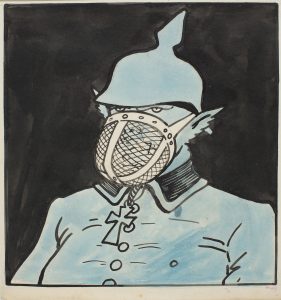
The journalist, businessman and collector Miquel Agell Nadal (Granollers, 1892-Barcelona, 1949) purchased over 16,000 works by leading names in the history of Catalan drawing, which enrich the material from the last third of the nineteenth and the first third of the twentieth century conserved by the Museu Nacional d’Art de Catalunya’s Cabinet of Drawings and Prints.
We are unaware of the circumstances that led to Miquel Agell possessing such a large volume of graphic work. Purchased in 1963, the collection is made up above all of the originals that were reproduced in two of the longest-lived and most popular Catalan satirical magazines of all time: La Campana de Gràcia (1870-1934) and L’Esquella de la Torratxa (1872-1938), and their respective almanacs.
The first publisher of both magazines was Innocenci López Bernagossi (Girona, 1829-1895), the owner of the Llibreria Espanyola in the Rambla del Mig in Barcelona, on the ground floor of the Hotel Oriente. At once a bookshop and a publishing house, it was a very small place in the city centre where artists, writers, politicians, actors and singers could meet – local, or passing through the city, like the divine Sarah Bernhardt – which made it a remarkable commercial success.
In La Campana de Gràcia and L’Esquella de la Torratxa, López Bernagossi transmitted his republican ideology and his anticlerical leanings, as did his son and successor Antoni López Benturas (Barcelona, 1861-1931). A great friend of Santiago Rusiñol, and the publisher of the books written by him, who, as well as being a member of the social set at the bookshop, published nearly 900 articles in L’Esquella under the pseudonym Xirau and curiously was born and died in the same years as his friend, we know that López Benturas died a ruined man. This is indicated by, among other witnesses, his son Antoni López Llausàs (Barcelona, 1888 – Buenos Aires, 1979), who took over and ran the family business until, after falling out with his father, he set up on his own and eventually founded the Llibreria Catalònia bookshop in Barcelona and, by then in exile in Buenos Aires, the Editorial Sudamericana.
Concerning the sale of the López publishing house
It therefore seems rather implausible that Miquel Agell should have purchased his splendid collection of drawings from Antoni López Llausàs. This is because Antoni López Benturas’ heir was not – as has sometimes been stated – his elder son Antoni, but his younger one, Rafael (?, 1892 – Barcelona, 1949).
The obituary in La Nostra Revista, published in Mexico City under the editorship and management of Avel·lí Artís Gener, Tísner (Barcelona, 1912-2000) refers to this. The latter was the outstanding figure who gave L’Esquella de la Torratxa a new lease of life during the Civil War, together with the writer Pere Calders.
Josep Maria Cadena, for his part, points out in his article in the catalogue dedicated to Josep Bartolí in 2002 that due to the collapse of López Benturas’ business affairs, Rafael López Llausàs was the architect of the sale of La Campana de Gràcia to a group of leaders of the political party Esquerra Republicana de Catalunya, and the closure, in 1934, of the Llibreria Espanyola:
“[…] having sold off in bundles – as the draughtsman Antoni Roca recalls in Tot fent memoria (1973) – his fabulous historical archive of original drawings published by La Campana de Gràcia and L’Esquella de la Torratxa under the porches of Plaça Reial […].”
After La Campana de Gràcia disappeared as a result of the so-called Events of October 1934, in 1938 L’Esquella de la Torratxa did so too. Two years earlier it had been seized by the Professional Draughtsmen’s Union, part of the UGT (Unió General de Treballadors), and from February 1937 it belonged to the Draughtsmen’s Cell of the PSUC (Partit Socialista Unificat de Catalunya).
Miquel Agell Nadal, a charismatic collector
The son of Esteve and Teresa, Miquel Agell Nadal was born in Granollers on 10 February 1892 into a family with Catholic convictions and traditionalist ideas who were seed and grain merchants. Five years later, the Agell family moved to the Sants district of Barcelona, where it opened a shop selling groceries and cakes.
After studying at the city’s Higher School of Commerce, everything suggests that before the Civil War Miquel Agell combined working in his parents’ shop with Carlist political activity and writing as a journalist in newspapers sympathetic to this cause like, among others, El Correo Catalán, for which he wrote for 15 years.
According to what his family has told us, Miquel Agell was a charismatic man, who had a way with people, a sense of humour and a good eye for business. Apart from the material now in the Museu Nacional d’Art de Catalunya, he built up an eclectic collection, including newspapers, magazines, antiques and paintings. Interested in culture, his restlessness led him to draw, write poems and even act at the Catholic Centre in Sants, with some success.

In 1925 together with his brothers he started publishing the Gaceta de Sans. Periòdic de sabor local. It was an annual publication that advertised the delicacies sold in the family’s shop, Casa Agell, during the Christmas period. Along with texts that generally praised the establishment, it featured illustrations by Gaietà Cornet, Miret, Joan, Malloz, Castanys, Llaverias, Abel and Moreno, among other draughtsmen.
The founder of various companies, Miquel Agell’s best-known business was without doubt the Mesón de las Golosinas Españolas, a shop that opened in the centre of Barcelona, in Avinguda del Portal de l’Àngel, just after the end of the Civil War.
El Mesón de las Golosinas Españolas
At the Mesón de las Golosinas Españolas, Miquel Agell successfully introduced art as an advertising gimmick. The advertising image of this paradise of sweets and cakes was El mesonero (The Innkeeper), by Joan Garcia Junceda: a stout smiling gentleman who was dressed in shirt sleeves and an apron, wore eighteenth-century stockings and shoes, and handed out sweets that he took out of a large bag. Joan Bazan Castro transferred, with some modifications, Junceda’s drawing to the bookplate “MIQVEL / AGELL / NADAL” which bears the legend “PREVENISTI [sic] / EUM IN BENEDIC / TIONIBUS / DULCE / DINIS”.
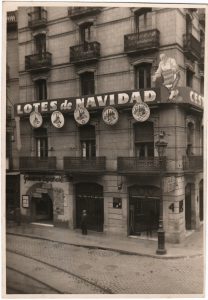
El Mesón de las Golosinas Españolas was mentioned regularly in the press. In the full-page photographic report in La Vanguardia of 15 April 1943, the ceramic panels that flanked the doorway are visible. On one it says: “Se sirven buenas meriendas / en los bajos del Mesón / a los que han apetito / y en la bolsa algún doblón” (Good snacks are served / downstairs in the Mesón / to those with an appetite / and a coin in their pocket). In another image you can see displayed “[…] bartolillos de Madrid, ‘xuxos’ de Gerona, tortas de Alcázar, mantecados de Astorga, y otros apetitosos dulces que nos vuelven la boca agua” (sweet pastries from Madrid, “xuxos” from Gerona, cakes from Alcázar, crumbly biscuits from Astorga, and other appetizing sweets to make your mouth water).
From newspaper articles we also know that the versatile artist from Sarrià, Pere Queraltó (Barcelona, 1889-1967), installed in the rooms of El Mesón de las Golosinas Españolas a panorama of the city of Zaragoza in 1943, a diorama of Montserrat in 1944 and a Nativity tableau that lit up in the evenings and whose background was the village of Palau-Solità, in El Vallès, in 1945.
Among other news items about Miquel Agell’s artistic commissions, it is on record that the ceramicist from Sants Salvador Sunet Urgellés (Barcelona, 1891-1949) contributed to the décor of El Mesón with a ceramic panel showing horse-riders from the Tres Tombs procession in Sant Andreu with ring-shaped bread rolls over their arms. But surely the most spectacular work that this artist did for Agell – together with his son Salvador Sunet Pahissa (Barcelona, 1918-1997) – was the ceramic support for a theme dear to the owner of El Mesón’s heart, the Corpus Christi procession in Barcelona, in the eighteenth century, which it is said was 14 metres long.
The first sale of the Agell Collection
Aged 45 and with two sons – Miquel Lluís and Josep Oriol – Miquel Agell was locked up in the Model prison in Barcelona from 26 March to 13 July 1937.
Jesús Alturo i Perucho devotes a chapter in his book El calze i la lira entre reixes (2008) to the poem that Agell wrote in Catalan and must have translated into Castilian about the celebration of Corpus Christi, on 28 May 1937.
In the Agell family archive there are two items of news that could be associated with the collection that is now in the Museu Nacional. One is a notice that says: “Half of the money raised by the sale of these drawings will be set aside for charitable purposes for the prisoners, to be distributed by the President of the Prisoners’ Committee on this Corridor.” The other is a sheet of paper handwritten on both sides, where there is a list of 74 works in total. It includes register numbers, artists’ names, a valuation of between 1 and 15 pesetas for each work and some surnames. There is a sum total on each side; on one “100 pts”, “12/4/37 55 pts. á Gavin”, and on the other “54 pts”, “á Gavin 27 pts. 9/5/37”.
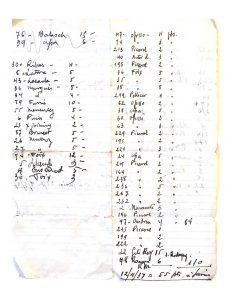
These figures mean that Miquel Agell gave half of the money obtained from the sales of drawings – that he made in two sessions – to the president of the corridor committee where he was imprisoned, Miquel Gavín Sagàrdia, a Catholic and like him a member of the jaumista faction, supporting the Carlist pretender Jaume de Borbó i de Borbó Parma. The works were by Marià Foix (Barcelona, 1860-1914), Ricard Opisso, Baldomer Gili Roig, Feliu Elias, Apa, Jaume Juez, Xirinius (Barcelona, 1906-2002) and a large number of productions by Josep Costa Ferrer, Picarol (Eivissa, 1876 – Palma, 1971), which different people must have bought – he wrote down some of their surnames. We understand that these drawings belonged to the collection of the López publishing house that Miquel Agell had bought, we do not know when or from whom, and which must have been part of what we might call the first sale of the Agell Collection.
Paradoxically, Miquel Agell’s political leanings and religious beliefs could not have been further from the republicanism and anticlericalism that the articles and jokes in La Campana de Gràcia and L’Esquella de la Torratxa and their respective almanacs ardently disseminated. But despite that he collected and looked after almost 17,000 works.
The second sale of the Agell Collection
It was Montserrat Puigdomènech, Miquel Agell’s widow, who offered the collection of drawings purchased by her husband from the Editorial López for sale to the Barcelona Museums Board.
On 12 April 1962, the board agreed to appoint a committee made up of the History professor and journalist Alberto del Castillo (Oñati, 1899 – Barcelona, 1976); the then director of the Museum of City History and the Archive of the Crown of Aragon Frederic Udina (Barcelona, 1914-2011); the historian Josep Maria Garrut (Barcelona, 1915-2008) and the director general of the Art Museums of Barcelona and director of the Museum of Art of Catalonia, Joan Ainaud (Barcelona, 1919-1995), so that they could determine the collection’s interest and value.
According to what the Agell family has told us, Frederic Udina was an acquaintance of Miquel Lluís Agell Puigdomènech’s. It is possible, therefore, that the latter might have had a word with Udina about the family’s collection and Udina offered to make the appropriate approaches to the City Council, in favour of the collection entering a public institution.
At the session of the Museums Board held on 9 June 1962, a favourable report was presented concerning the purchase of the originals – considered irreplaceable with regard to knowledge of the art of illustration in Barcelona – for a minimum of 250,000 pesetas.
A decree by the mayor of Barcelona of 27 May 1963 authorized the abovementioned expenditure for the purchase of the collection. Since then, the unique, fascinating Agell Collection – which, after a recent review, we would now go so far as to say is made up of around 16,698 works by more than 500 different artists – has been conserved in the Museu d’Art/Museu Nacional d’Art de Catalunya.
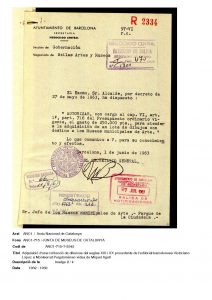
An assessment of the contents of the Agell Collection
Broadly speaking we can state that it is a collection that clearly shows the historical conditions that determined its development. To begin with, it was the result of a process of accumulation, almost at random, without there being, on the part of its owner, a prior wish to build up a collection with specific objectives. It is therefore normal that one of its main distinctive characteristics should be its heterogeneous nature, to which one must add its unevenness.
In any case, these limitations do not make it any less valuable, or meritorious, since it is a group of great artistic importance and great historical interest, which reflects the importance of humorous drawing (cartoons), associated with the emergence of periodical publications in the Catalan press, in a period of great political turbulence and major social strife. In this context, as has been said, La Campana de Gràcia and L’Esquella de la Torratxa became two weekly publications, political in nature, essential for understanding the work done by a large number of draughtsmen, illustrators, known popularly as caricaturists, who with their imagination and their talent contributed to the success of the publications.
Beyond the formative vicissitudes, we wish to make an assessment of some aspects of the content and the main characteristics. The first aspect we must point out is the quantitative importance. We mentioned earlier that it is a group made up of more than 16,000 original drawings, which makes it by far the Cabinet of Drawings and Prints’ largest collection. One only has to remember that with regard to the volume of works, second place is occupied by the collection built up by the writer and art critic Raimon Casellas, made up, mostly, of a group of more than 4,000 old drawings.
Third position is held by the collection of the versatile artist Apel·les Mestres, which also contains more than 4,000 works. In this case, unlike the two previous ones – Agell and Casellas – it is not a repertoire made up of a wide range of artists, nor, as is the case with the Casellas Collection (15th – 20th C), does it allow us to study a very long period of time. On the other hand, except for just a few, the majority of the compositions which form the Apel·les Mestres Collection are creations by the artist himself and they have a limited chronological scope, basically their creator’s career as an artist.
To be able to assess the true dimensions of the Agell Collection, one must remember that it represents almost a third of the total number of drawings in the Cabinet of Drawings and Prints, 50,000 approximately. Without doubt, this quantitative criterion is a fairly illustrative indicator of a collection that reveals to us the emergence of the phenomenon of graphic humour in Catalonia. It is true of course that the Cabinet’s collection also includes some episodes that fall within this same theme, by other artists like, for example, Ramon Casas, Feliu Elias, Apa, Xavier Nogués (Barcelona, 1873-1941), Modest Urgell, Apel·les Mestres, Xavier Gosé, Isidre Nonell and Ismael Smith (Barcelona, 1886 – New York, 1972), to mention just a few of those who drew cartoons, whether in the form of caricatures or as one-off contributions to periodicals of the time. However, none of these episodes can be compared – in significance and importance – with what is represented by a collection that, from this point of view, forms a monolithic block without any thematic interference.
Not even the Partagàs Collection, made up of a group of over 900 drawings, shows the same homogeneity, even though it also has some things in common, given that much of the material is also related directly to the practice of illustration.
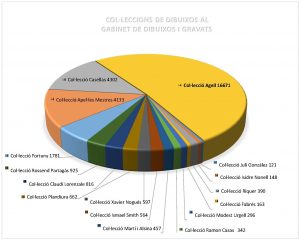
Related links
Collectors that have made museums
Francesc Quílez
and
Gabinet de Dibuixos i Gravats







